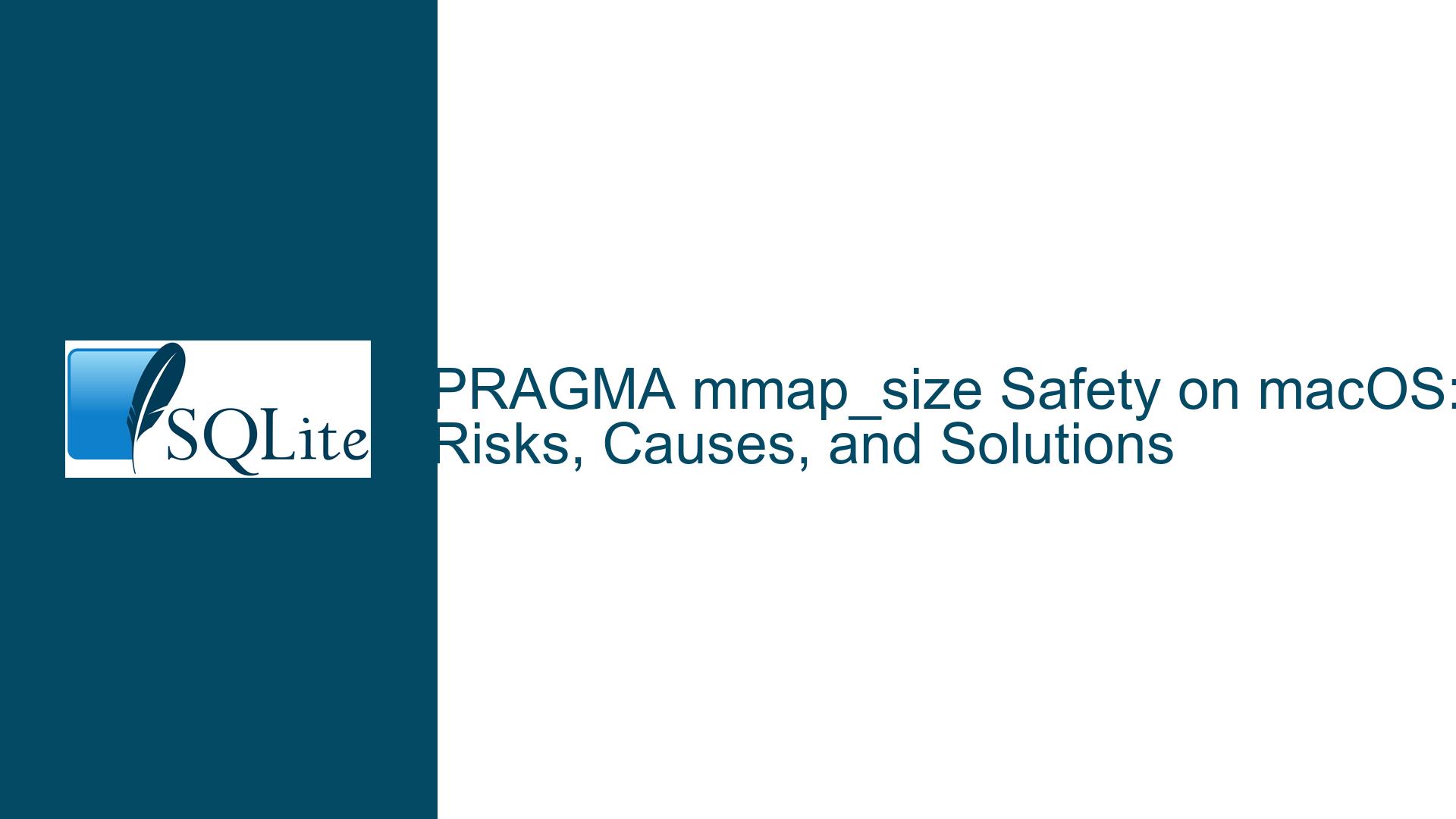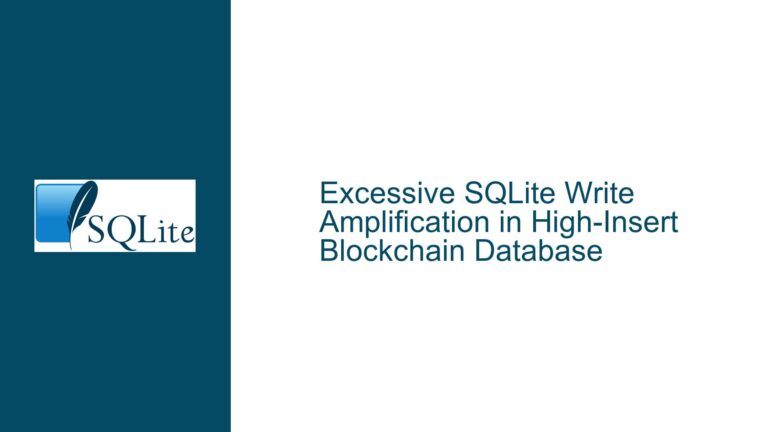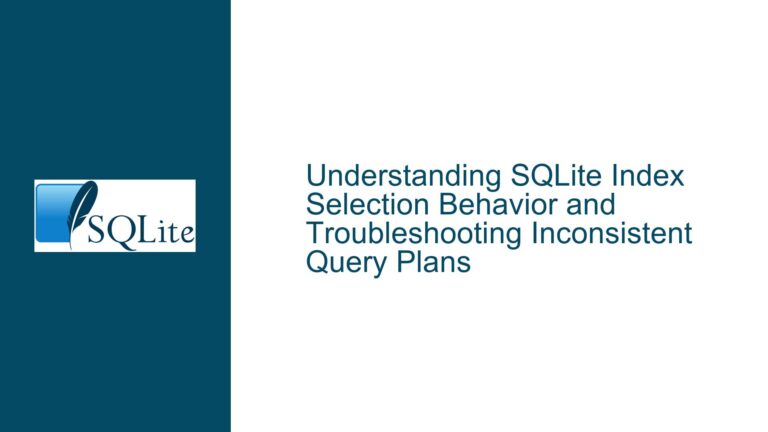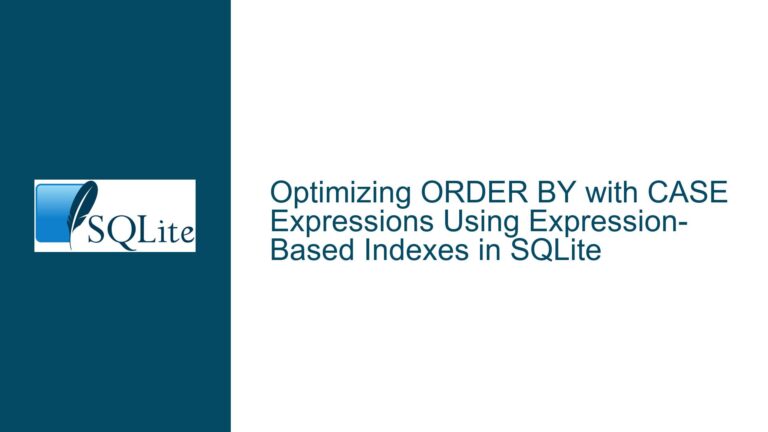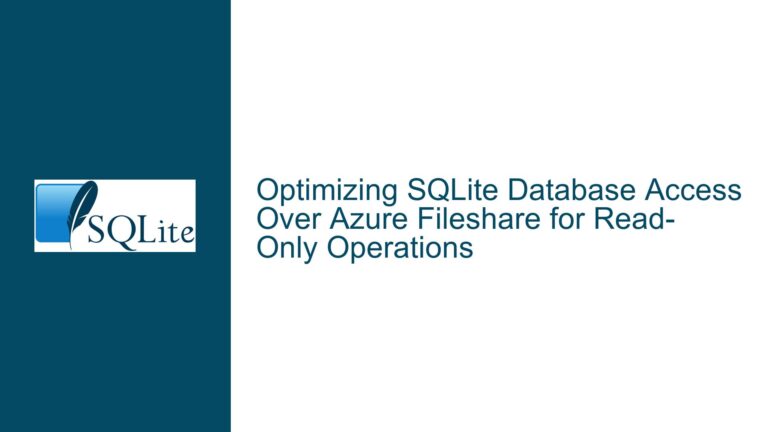PRAGMA mmap_size Safety on macOS: Risks, Causes, and Solutions
Understanding macOS mmap Vulnerabilities and SQLite’s Historical Context
The use of PRAGMA mmap_size in SQLite on macOS has been a topic of debate for years due to historical concerns about file corruption and instability. This directive configures SQLite to use memory-mapped I/O (mmap) for accessing database files, bypassing traditional file read/write syscalls like pread and pwrite. While mmap can theoretically improve performance by reducing kernel-to-user-space data copying, its implementation on macOS (and Darwin-based systems like iOS) has been plagued by unique risks tied to the operating system’s memory management, filesystem behavior, and error-handling mechanics.
Historical Concerns: macOS Kernel Bugs and mmap
In 2017, developers observed sporadic file corruption when using PRAGMA mmap_size on macOS. Investigations pointed to a kernel-level bug where the macOS filesystem failed to synchronize memory-mapped pages after writes, leading to stale data persisting in the mmap region. This issue was particularly insidious because SQLite relies on atomicity and durability guarantees when committing transactions. If the mmap region did not reflect the latest on-disk state, transactions could overwrite valid data or fail to persist changes entirely.
While the exact macOS version where this bug was resolved remains undocumented, subsequent improvements to the Darwin kernel’s handling of mmap synchronization (via mechanisms like msync and enhanced filesystem journaling) have mitigated many of these risks. However, the SQLite community’s cautionary stance toward mmap persists due to broader stability concerns unrelated to data corruption, such as abrupt process termination during I/O errors.
The Role of the WAL Index and Mandatory mmap Regions
One critical exception to the general mmap debate is SQLite’s Write-Ahead Logging (WAL) mode. The WAL index—a shared memory region tracking active transactions—is always memory-mapped, even if PRAGMA mmap_size is disabled. This is because the WAL index requires low-latency, concurrent access across processes, which mmap uniquely provides. On macOS, this forced usage of mmap for the WAL index has exposed edge cases where filesystem operations (e.g., truncating the database file to zero bytes) could dereference invalid memory addresses, crashing the process.
SQLite’s Darwin-specific builds include mitigations for these scenarios, such as intercepting SIGBUS signals and converting them into SQLITE_IOERR_VNODE errors. However, these fixes apply only to the WAL index’s mmap region. User-configured mmap regions (via PRAGMA mmap_size) do not benefit from the same protections, leaving applications vulnerable to crashes if the underlying storage becomes unavailable (e.g., unmounting a USB drive) or encounters unrecoverable I/O errors.
Performance Tradeoffs: mmap vs. Traditional I/O
A common misconception is that mmap universally accelerates database operations by reducing syscall overhead. Benchmarking on Darwin systems reveals a more nuanced picture. While mmap reduces kernel-space CPU cycles (by delegating page caching to the virtual memory subsystem), it increases user-space overhead due to the need to manage memory access patterns and fault handling. In write-heavy workloads, SQLite’s built-in page cache (managed via PRAGMA cache_size) often outperforms mmap, as it avoids the cost of frequent page faults and TLB misses.
Furthermore, macOS’s unified buffer cache (which shares memory between the filesystem and virtual memory subsystems) negates many of mmap’s theoretical advantages. When using traditional I/O methods like pread, data copied into user-space buffers is often already resident in the kernel’s page cache, minimizing redundant memory consumption.
Identifying macOS-Specific Risks: Why mmap Can Lead to Instability
1. Filesystem Unmounting and Storage Revocation
Memory-mapped regions become invalid immediately if the underlying storage device is unmounted or disconnected (e.g., ejecting a USB drive). Any subsequent access to the mmap region triggers a SIGBUS signal, which SQLite cannot handle gracefully, resulting in process termination. Traditional I/O methods, by contrast, return ENOENT or EIO error codes, allowing SQLite to roll back transactions and notify the application.
On internal volumes (e.g., the boot disk), storage revocation is less common but not impossible. For example, APFS snapshots or volume cloning operations can transiently mark disk blocks as read-only, causing write operations to fail with ENOSPC even if free space exists. In mmap-based workflows, these errors manifest as segmentation faults rather than recoverable exceptions, risking data loss and application crashes.
2. File Truncation and Zero-Byte Edge Cases
Truncating a memory-mapped file to zero bytes (e.g., via ftruncate) invalidates all existing mmap regions associated with the file. On macOS, this operation is not atomic with respect to concurrent accesses, leading to race conditions where SQLite may attempt to read from a region that no longer exists. This issue is exacerbated in WAL mode, where the WAL index’s mmap region is essential for transaction coordination. Crash reports often implicate walIndexTryHdr—a function that validates the WAL header—as it accesses the mmap region immediately after a transaction begins.
3. Signal Handling Limitations
Unlike traditional I/O errors, which return negative error codes to user space, mmap-related faults (e.g., accessing unmapped pages) generate signals (SIGBUS, SIGSEGV). Signal handlers cannot resume execution safely after such faults, forcing the process to terminate. While SQLite’s Darwin port includes limited signal handling to convert these crashes into SQLITE_IOERR codes, this mitigation applies only to the WAL index’s mandatory mmap region. User-configured mmap regions lack equivalent safeguards, making them prone to unhandled crashes.
4. Resource Overcommit and Copy-on-Write Pitfalls
Darwin’s filesystem layers (e.g., APFS) employ copy-on-write (CoW) semantics for disk blocks to optimize snapshot and clone operations. When a CoW block is modified, the filesystem must allocate a new block if the original is shared. If the volume is near capacity, this allocation can fail, returning ENOSPC to write operations. In mmap-based workflows, such errors are not detected until the kernel attempts to flush dirty pages to disk, at which point the process has already executed the transaction logic. The resulting SIGBUS crash discards any in-memory state, including non-database data, amplifying data loss risks.
Mitigation Strategies: Avoiding mmap Pitfalls on macOS
1. Disable mmap for User-Configured Regions
Set PRAGMA mmap_size = 0 during database initialization to avoid mmap for non-WAL-index regions. This forces SQLite to use pread/pwrite for all I/O operations, ensuring errors are returned as codes rather than signals. For applications requiring large contiguous reads, increase the page cache size instead:
PRAGMA cache_size = -10000; -- Allocate 10,000 pages (40MB if page_size=4KB)
2. Handle Storage Revocation Gracefully
Monitor filesystem events (e.g., using FSEvents or NSFilePresenter) to detect volume unmounts or storage failures. Upon receiving such notifications, immediately close the database connection and invalidate any cached file descriptors. Reopen the database only after confirming the storage is available.
3. Avoid Truncation During Active Transactions
Ensure no concurrent transactions are active when truncating the database file. If truncation is unavoidable (e.g., during vacuum operations), temporarily disable WAL mode:
PRAGMA journal_mode = DELETE;
-- Perform truncation/vacuum here
PRAGMA journal_mode = WAL;
4. Leverage SQLite’s Built-In Error Recovery
Enable SQLITE_CONFIG_LOOKASIDE to optimize memory allocation for transient objects (e.g., cursor structures). This reduces contention on the heap allocator, offsetting the performance penalty of disabling mmap:
sqlite3_db_config(db, SQLITE_DBCONFIG_LOOKASIDE, NULL, 0, 0);
5. Benchmark and Optimize Alternative Caching Strategies
For read-heavy workloads, experiment with increasing the page cache size and leveraging OS-level read-ahead. Use PRAGMA temp_store = MEMORY to store temporary objects in RAM, reducing I/O pressure.
6. Validate macOS Kernel and Filesystem Behavior
Test database operations under controlled failure scenarios (e.g., sudden storage disconnection, disk space exhaustion) to identify mmap-related instability. Use tools like dtrace or fs_usage to profile syscall activity and page faults, comparing mmap vs. traditional I/O performance.
7. Adopt Defensive File Management Practices
- Avoid storing databases on removable media.
- Use
fcntl(F_FULLFSYNC)after critical writes to ensure metadata durability. - Monitor for
SQLITE_IOERR_VNODEerrors, which indicate mmap-related issues in the WAL index.
By prioritizing SQLite’s native I/O mechanisms over mmap and adopting robust error-handling practices, developers can maintain database stability on macOS without sacrificing performance. Historical kernel bugs may have subsided, but the fundamental risks of mmap in Darwin’s signal-driven error model remain a compelling reason to avoid it.
